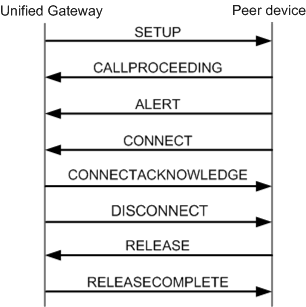Navigation: Fault Management > Troubleshooting Guide > Trunk Faults > Background >
The QSIG trunk signaling process varies according to the user type.
Basic Concept
QSIG trunk is a digital circuit trunk that connects the peer device with the E1/T1 cable.
The QSIG trunk uses QSIG signaling, which is based on the network/user model, as the control signaling. If one end of the QSIG link connects to the network, the other end connects to a user.
Signaling Process
A SIP user in unified gateway calls a user in peer device, as shown inFigure 1.
Figure 1 Normal signaling process for a call initiated by a SIP user

The signaling process is described as follows:
1.When an intra-office user calls an peer user, unified gateway sends a SETUP message, requesting to set up a call.
2.Peer device returns a CALLPROCEEDING message, indicating that the call is being set up.
3.Peer device sends an ALERT message, indicating that the phone of the peer user rings.
4.Peer device sends a CONNECT message, indicating that the peer user picks up the phone.
5.unified gateway sends a CONNECTACKNOWLEDGE message, indicating that the intra-office has learned that the peer user has picked up the phone.
6.The intra-office user starts to talk with the peer user.
7.The unified gateway sends a DISCONNECT message, indicating that the intra-office user disconnects the call.
8.Peer device sends a RELEASE message, indicating that the peer user hangs up.
9.unified gateway sends a RELEASECOMPLETE message, indicating that the intra-office user hangs up. unified gateway and peer device release channel resources.
![]()
If the intra-office user is callee user, the signaling process is oppositional.
Parent Topic: Background